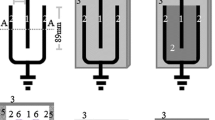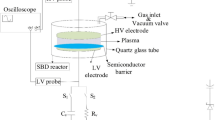Abstract
Shielded sliding discharges are nanosecond streamer discharges which develop along a dielectric between metal foil electrodes, with one of the foils extended over the entire rear of the dielectric layer. The electrode configuration not only allowed rearranging discharges in parallel due to the decoupling effect of the metal layer, but also to modify the electric field distribution in such a way that components normal to the surface are enhanced, leading to an increased energy density in the discharge plasma. By varying the electrode gap, the applied voltage, and the repetition rate, it is shown that by keeping the average electric field constant, the discharge voltage can be reduced from tens of kV to values on the order of a few kV, but only at the expense of a reduced energy density of the plasma. Varying the repetition rate from 20 to 500 Hz resulted in a slightly reduced energy per pulse, likely caused by residual charges on the dielectric surface. Measurements of the NO conversion to NO2 and ozone synthesis in dry air showed that the conversion is only dependent on the energy density of the discharge plasma. Although reducing the pulse voltage from the tens of kV range to that of few kV, and possibly even lower, causes a reduction in energy density, this loss can be compensated for by increasing the electrode gap area. This and the possibility to form discharge arrays allows generating large volume discharge reactors for environmental applications, at modest pulsed voltages.












Similar content being viewed by others
References
Mizuno A (2007) Industrial applications of atmospheric non-thermal plasma in environmental remediation. Plasma Phys Control Fusion 49:A1–A15
Akiyama H, Sakugawa T, Namihira T, Takaki K, Minamitani Y, Shimomura N (2007) Industrial applications of pulsed power technology. IEEE Trans Dielecrt Electr Insul 14:1051–1064
Winands HGJJ, Yan K, Nair SA, Pemen GAJM, van Heesch BEJM (2005) Evaluation of corona plasma techniques for industrial applications: HPPS and DC/AC systems. Plasma Process Polym 2:232–237
Vandenbroucke AM, Morent R, Geyter ND, Leys C (2011) Non-thermal plasmas for non-catalytic and catalytic VOC abatement. J Hazard Mater 195:30–54
Okubo M, Kametaka H, Yoshida K, Yamamoto T (2007) Odor removal characteristics of barrier-type packed-bed nonthermal plasma reactor. Jpn J Appl Phys 46:5288–5293
Wintenberg KK, Sherman DM, Tsai PPY, Gadri RB, Karakaya F, Chen Z, Roth JR, Montie TC (2000) Air filter sterilization using a one atmosphere uniform glow discharge plasma (the volfilter). IEEE Trans Plasma Sci 28:64–71
Nishikawa K, Nojima H (2003) Airborn virus inactivation technology using cluster ions generated by discharge plasma. Sharp Tech J 86:10–15
Vaze ND, Gallagher MJ, Park S, Fridman G, Vasilets VN, Gutsol AF, Anandan S, Friedman G, Fridman AA (2010) Inactivation of bacteria in flight by direct exposure to nonthermal plasma. IEEE Trans Plasma Sci 38:3234–3240
Agrawal SR, Kim HJ, Lee YW, Sohn JH, Lee JH, Kim YJ, Lee SH, Hong CS, Park JW (2010) Effect of an air cleaner with electrostatic filter on the removal of airborne house dust mite allergens. Yonsei Med J 51:918–923
Petitpas G, Rollier JD, Darmon A, Gonzalez-Aguilar J, Metkemeijer R, Fulcheri L (2007) Acomparative study of non-thermal plasma assisted reforming technologies. Int J Hydrogen Energy 32:2848–2867
Chen HL, Lee HM, Chen SH, Chao Y, Chang MB (2008) Review of plasma catalysis on hydrocarbon reforming for hydrogen production—interaction, integration, and prospects. Appl Catal B Environ 85:1–9
Cho BK, Lee J-H, Crellin CC, Olsona KL, Hilden DL, Kim MK, Kim PS, Heo I, Oh SH, Nam I-S (2012) Selective catalytic reduction of NOx by diesel fuel: plasma-assisted HC/SCR system. Catal Today 191:20–24
Lee DH, Lee JO, Kim KT, Song YH, Kim E, Han HS (2012) Hydrogen in plasma-assisted hydrocarbon selective catalytic reduction. Int J Hydrogen Energy 37:3225–3233
Malik MA, Schoenbach KH (2012) New approach for sustaining energetic, efficient and scalable non-equilibrium plasma in water vapours at atmospheric pressure. J Phys D Appl Phys 45:132001
Malik MA, Xiao S, Schoenbach KH (2012) Scaling of surface-plasma reactors with a significantly increased energy density for NO conversion. J Hazard Mater 209–210:293–298
Bloshchitsyn V (2010) Review of surface discharge experiments. http://arxiv.org/abs/1005.5044v1
Furmanski J, Kim JY, Kim SO (2011) Triple-coupled intense atmospheric pressure plasma jet from honeycomb structural plasma device. IEEE Trans Plasma Sci 39:2338–2339
Kumara S, Alam S, Hoque IR, Serdyuk YV, Gubanski SM (2012) DC flashover characteristics of a polymeric insulator in presence of surface charges. IEEE Trans Dielectr Electr Insul 19:1084–1090
Malik MA, Schoenbach KH (2013) Sliding discharges in steam: effects of dielectric surface and hydrocarbon additives on hydrogen, oxygen and hydrogen peroxide generation. J Phys D Appl Phys 46:145201
Kim HH, Prieto G, Takashima K, Katsura S, Mizuno A (2002) Performance evaluation of discharge plasma process for gaseous pollutant removal. J Electrostat 55:25–41
Malik MA, Schoenbach KH (2013) Nitric oxide conversion and ozone synthesis in a shielded sliding discharge reactor with positive and negative streamers. Plasma Chem Plasma Process. doi:10.1007/s11090-013-9497-x
Mok YS, Nam IS (2004) Reduction of nitrogen oxides by ozonization–catalysis hybrid process. Korean J Chem Eng 21:976–982
Jensen TK, Jørgensen L, Ørtenblad M, Stamate E, Simonsen P, Tobiassen L, Energy DONG (2008) NOx reduction obtained by low-temperature plasma generated ozone. In: International Gas Union research conference 2541–2552. http://www.dgc.eu/sites/default/files/filarkiv/documents/C0801_nox_reduction.pdf. Accessed on Sep 31 2013
Stamate E, Irimiea C, Salewski M (2013) Investigation of NOx reduction by low temperature oxidation using ozone produced by dielectric barrier discharge. Jpn J Appl Phys 52:05EE03
Okubo M, Fujishima H, Yamato Y, Kuroki T, Tanaka A, Otsuka K (2013) Towards ideal NOx and CO2 emission control technology for bio-oils combustion energy system using a plasma-chemical hybrid process. J Phys Conf Ser 418:012115
Samaranayake WJM, Miyahara Y, Namihira T, Katsuki S, Sakugawa T, Hackam R, Akiyama H (2000) Pulsed streamer discharge characteristics of ozone production in dry air. IEEE Trans Dielectr Electr Insul 7:254–260
Simek M, Clupek M (2002) Efficiency of ozone production by pulsed positive corona discharge in synthetic air. J Phys D Appl Phys 35:1171–1175
Huang W, Ren T, Xia W (2007) Ozone generation by hybrid discharge combined with catalysis. Ozone Sci Eng 29:107–112
Buntat Z, Smith IR, Razali NA (2009) Ozone generation by pulsed streamer discharge in air. Appl Phys Res 1:2–10
Pekarek S (2012) Experimental study of surface dielectric barrier discharge in air and its ozone production. J Phys D Appl Phys 45:075201
Sretenović GB, Obradović BM, Kovačević VV, Kuraica MM (2012) Pulsed corona discharge driven by Marx generator: diagnostics and optimization for NOx treatment. Curr Appl Phys 13:121–129
van Heesch EJM, Winands GJJ, Pemen AJM (2008) Evaluation of pulsed streamer corona experiments to determine the O* radical yield. J Phys D Appl Phys 41:234015
Buntat Z, Smith IR, Razali NA (2009) Ozone generation using atmospheric pressure glow discharge in air. J Phys D Appl Phys 42:235202
Sathiamoorthy G, Kalyana S, Finney CW, Clark RJ, Locke BR (1999) Chemical reaction kinetics and reactor modeling of NOx removal in a pulsed streamer corona discharge reactor. Ind Eng Chem Res 38:1844–1855
Kogelschatz U, Eliasson B, Hirth M (1988) Ozone generation from oxygen and air: discharge physics and reaction mechanisms. Ozone Sci Eng 10:367–377
Penetrante BM, Brusasco RM, Merritt BT, Vogtlin GE (1999) Environmental applications of low-temperature plasmas. Pure Appl Chem 71:1829–1835
Obradović BM, Sretenović GB, Kuraica MM (2011) A dual-use of DBD plasma for simultaneous NOx and SO2 removal from coal-combustion flue gas. J Hazard Mater 185:1280–1286
Malik MA, Jiang XZ (2000) Catalyst assisted destruction of trichloro ethylene and toluene in corona discharges. J Environ Sci China 12:7–11
Huang W, Ren T, Xia W (2007) Ozone generation by hybrid discharge combined with catalysis. Ozone Sci Eng 29:107–112
Chang MB, Chang CC (1997) Destruction and removal of toluene and MEK from gas streams with silent discharge plasmas. AIChE J 43:1325–1330
Blin-Simiand N, Jorand F, Belhadj-Miled Z, Pasquiers S, Postel C (2007) Influence of temperature on the removal of toluene by dielectric barrier discharge. Int J Environ Sci Technol 1:64–70
Acknowledgments
This work is supported by a Commonwealth Research Commercialization Fund grant (MF13-019) from Virginia’s Center for Innovative Technology, ‘Frank Reidy Fellowship in Environmental Plasma Research’ and with internal funds of the Frank Reidy Research Center for Bioelectrics.
Author information
Authors and Affiliations
Corresponding author
Rights and permissions
About this article
Cite this article
Schoenbach, K.H., Malik, M.A. Scaling of Shielded Sliding Discharges for Environmental Applications. Plasma Chem Plasma Process 34, 39–54 (2014). https://doi.org/10.1007/s11090-013-9508-y
Received:
Accepted:
Published:
Issue Date:
DOI: https://doi.org/10.1007/s11090-013-9508-y




